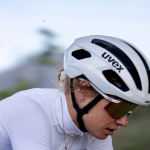Mountaineer Jamie Clarke and Hanesbrands Inc. research and development director Mike Abbott each wear a Champion Supersuit made with aerogel, an insulator made from silicon modified to contain microscopic pockets of air.
But despite the lack of the pillow-puffy down parka, hell likely be more worried about overheating than freezing, because of a space-age insulator outfitter Champion is using in his one-piece full-body “Supersuit.”
Aerogel, silicon modified to contain microscopic pockets of air – it’s often compared to “solid smoke” – was developed for use as industrial insulation, and it’s one of the best, lightest insulators around.
However, past tries to incorporate aerogel into coats have fallen flat. The problems? It cost a lot, is hard to work with and tended to insulate too well, causing wearers to overheat.
Champion parent Hanesbrands and Element 21, a Toronto company that licensed the aerogel technology, have spent two years and $2 million to solve those problems. If they succeed, they might have a competitor to competing insulators such as Thinsulate and Primaloft.
Hanesbrands is sponsoring Clarke’s Everest climb.
The company wants to push aerogel into even more mainstream applications, including mass-market Champion gear set to be sold at Target and other stores sometime next year. Hanes spokesman Matt Hall said any Champion item developed containing aerogel would be “significantly under $100.”
Is aerogel finally ready for its closeup? Maybe, thanks to evolving technology and steadily falling prices.
When Aspen Aerogels Inc., the company that makes the aerogel for the Champion suit, was founded in 2001, it mainly created insulation for NASA and the defense industry. It was exorbitantly expensive, CEO Don Young said.
Aspen, based in Northborough, Mass., lowered costs by opening up to new industrial markets, making its manufacturing more efficient by improving chemistry and lowering costs for its raw material. It has also expanded manufacturing, opening a plant in Rhode Island in 2008. It now plans to double the plant’s size.
That has brought Aerogel prices down from $50 to $100 per square foot in 2001 to 2003 to just $1.50 to $3 per square foot, Young said.
Others have tried and failed to use Aerogel in clothing.
Ann Parmenter, a climber who tests Aspen Aerogel products, wore insulated socks on an Everest climb in 2006 and said her feet got too hot. Hugo Boss put it in a high-end jacket several years ago, but it cost thousands of dollars. Only a few were sold before it was discontinued because of overheating.
Burton also sold an aerogel jacket in recent years, but at $550 it cost twice as much as its non-aerogel jacket and was also pulled from the market.
Mike Abbott, Hanesbrands director of research and development, said Element 21 and Hanesbrands are trying to battle overheating with a four-layer garment: an aerogel layer sealed between a layer that wicks away sweat, a layer that insulates to keep in body heat and a layer that resists wind.
Theyre not the only ones still working on aerogel. Russell Athletics is developing hunting gear, beginning with a high-end jacket that will cost $395 and come out later this year.
Climbers are eager to find out if the new jackets really do solve the problems of the past.
“Can outdoor clothing manufacturers deliver a high-quality product, in quantity, at a consumer price point using aerogel?” pondered avid climber Alan Arnette on his blog. “I hope so because I want one!”















